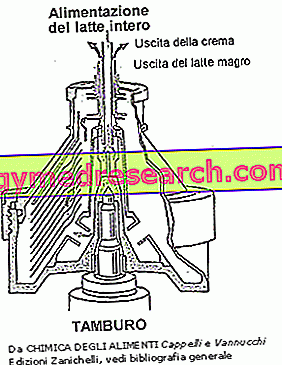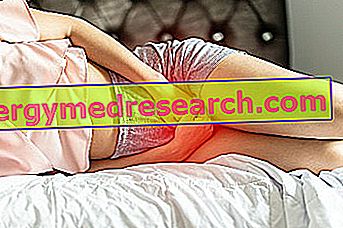Generality
What is cinnamon?
Cinnamon is a well-known spice of yellow-brown color, whose spicy flavor, embellished with sweetish nuances, enriches sweets and liqueurs of various types.
The aroma of cinnamon, dry and pungent, resembles that of cloves and is accompanied by peppery notes.

Botanical and cinnamon types
The cinnamon spice is made up of the dried bark of some trees, belonging to the Lauraceae family; among the best known are the species Cinnamomum zeylanicum (cinnamon proper) and Cinnamomum cassia (Chinese cinnamon).
The bark, freed from the outer cork and the underlying parenchyma, is fragmented, rolled up in multilayer and dried cylinders.
Fine cinnamon
The finest and most expensive quality is obtained from Cinnamomum zeylanicum, also called Cinnamomum vera ; it is a shrub originating from Sri Lanka (formerly Ceylon ), which still today remains the most important producer in the world. It is distinguished from other cinnamon varieties by its light color and sweet taste; it is presented in cylinders (called torches ) of 20-80 centimeters with a diameter of around 10 mm. It is harvested twice a year, in spring and autumn, after the rainy season.
Oriental cinnamon
Chinese cinnamon ( Cinnamomum cassia or Cinnamomum Aromaticum ) is characterized by a bright red color, with a less delicate aroma and flavors; it is produced in China, Bangladesh, India and Vietnam, is made up of shorter and thicker torches, and is placed at a lower quality step.
In general, the thinner the bark, the more valuable the drug is; moreover, the form in sticks - to be crumbled at the time of use - is preferable to powdered cinnamon, which in this form can be more easily sophisticated and tends to lose many of its original characteristics.
Cinnamon essential oil
Cinnamon essential oil is obtained from the leaves and young branches, by the steam current distillation method. It appears as a dark yellow liquid with a pleasant aroma and spicy aroma.
Cinnamon in Brief

- Used part: stem bark and dried twigs (cinnamon).
- Main components: contains about one percent of essential oil (eugenol, cinnamic aldehyde, etc.), tannins and polyphenols, including the "famous" epicatechins.
- Actions: antimicrobial, eupeptic, carminative, corrective.
- Use: dyspepsia, flatulence, meteorism.
Indications
When to use cinnamon?
Cinnamon has a long history: references are already found in China in 2700 BC and in the Bible (book of Exodus); we know that it was used by the ancient Egyptians for embalming and also mentioned in the Greek and Latin world.
Today, the use of cinnamon is not limited to the preparation of Christmas sweets, apple pies and mulled wine; in fact, beyond the culinary use, this drug recognizes some noteworthy phytotherapeutic applications.
In folk medicine, cinnamon is used as a remedy against:
- Infantile diarrhea
- Chills
- Flu symptoms
- Intestinal infestations
- Disinfectant for wounds
- Regularizing the menstrual flow
The most common applications of cinnamon in modern phytotherapy are:
- Cold related disorders, such as colds
- Dyspepsia
- Flatulence and intestinal colic.
It has also been suggested that cinnamon can improve premature ejaculation disorder.
Property and Effectiveness
Nutritional characteristics of cinnamon
Referred to 100 grams of dried cinnamon:
- Energy: 247Kcal
- Fats: 1.24g
- Carbohydrates: 55g
- of which sugars 2.17g
- Proteins: 3.99g
- Fibers: 53.1g.
What benefits has the essential cinnamon oil shown?
Like all sources rich in essential oils, cinnamon performs an action:
- antimicrobial
- Eupeptic (helps digestion)
- Astringent.
Topically, cinnamon oil clutches fight local infections and stimulate circulation. Also for external use, the essential oil is indicated for the deodorising and dermo-purifying properties, and - in the form of mouthwash - is also used in stomatitis (inflammation of the mucous membranes of the oral cavity) and in gingivitis.
We can therefore find cinnamon in phytotherapeutic products reserved for digestive problems, irritative disorders of the oropharyngeal cavity and seasonal flu illnesses.
Some evidence suggests that a specific cream containing cinnamon and other essential oils could improve the male discomfort of premature ejaculation.
What benefits has cinnamon powder shown?
Many of the effects of cinnamon have been demonstrated but inadequately. The evidences belong, for the most part, to small studies or carried out on modest research samples. Further details are required.
Cinnamon, blood sugar and diabetes
Recent studies have shown that cinnamon powder has a certain ability to lower plasma glucose levels, making it potentially useful in diabetes management. It is however a modest effect, achievable only at important doses (1-6 g / day in the form of crumbled torches of Cinnamomum cassia ); for this reason, the drug cannot be considered an alternative to the drugs used against diabetes.
Antioxidant cinnamon
Noteworthy is also its antioxidant power, while in popular tradition it is often depicted as an aphrodisiac.
Cinnamon neuroprotective activity
Preliminary evidence carried out on mice attribute to cinnamon a neuroprotective activity, particularly useful in cases of Alzheimer, other forms of dementia, Parkinson's disease and neurodegenerative diseases in general.
Other properties of cinnamon
Although marginally, cinnamon, alone or in complex products, has proven to be able to contribute to:
- Reduce the symptoms of hay fever
- Combat oral candidiasis
- Reduce intestinal symptoms, such as irritable bowel
- Improve the appetite
- Reduce menstrual pain
- Speed up remission from salmonellosis and intestinal parasite infestations etc.

Doses and Mode of Use
How to use cinnamon?
The phytotherapeutic properties of cinnamon are obviously greater for the essential oil and for the fluid extract, whose antiseptic action is valid both for ingestion and for external use.
The use of standardized pharmaceutical forms in their active ingredient content is always preferable. In general, the bark extracts are titrated in flavonoids, while the essential oil is titrated in eugenol and cinnamic aldehyde.
Cinnamon mouthwash
A few drops of essential oil, diluted in a glass of natural water, can be used for a mouthwash destined to rinse and gargle against inflammation of the oral cavity and gingivitis.
There are also applications for dried cinnamon powder.
Cinnamon herbal tea
In the form of herbal tea (infusion or decoction), cinnamon powder is used in doses of 0.5 / 1g of dried drug (bark) for 150 / 250ml of water.
The herbal tea is prepared by infusing the drug in boiling water for about 5 minutes, filtering it and drinking it several times a day.
The main disadvantage of this preparation is that there is no guarantee on the amount of active ingredients extracted from the infusion. An example of a digestive tea based on cinnamon is available on this page.
Cinnamon dosage
The appropriate dose of cinnamon depends on several factors such as
- Age of the user
- Health
- Pharmacological type (dry extract or essential oil).
You do not have enough information to determine an adequate dose for cinnamon bark.
Side effects
Can cinnamon trigger side effects?
Cinnamon essential oil - especially at high concentrations - can produce various side effects; therefore it is recommended to use it under the supervision of a doctor or pharmacist.
Side effects for internal use
Cinnamon (dried bark at high doses and essence even at normal dosages) can cause allergic or pseudo-allergic reactions in the skin and mucous membranes in predisposed people.
The most common side effects include:
- Tachycardia
- Enhanced intestinal peristalsis up to diarrhea
- tachypnoea
- Sweating
- In severe cases, convulsions
- A phase of sedation of the central nervous system, accompanied by drowsiness and depression, can follow.
Side effects for topical use
When used topically, cinnamon can trigger very irritating local irritations; it is therefore strongly advised against the use of cinnamon essential oil in concentrated (undiluted) form. In this regard, cases of:
- Dermatitis caused by cinnamon oil present in cosmetics and thermal mud
- Gingivitis caused by the use of essential oil in toothpastes.
Cinnamon essential oil can also be irritating to the mucous membranes of the gastrointestinal and urinary tract.
Contraindications
Cinnamon contains coumarin, a moderately toxic substance for liver and kidneys. It is therefore necessary to avoid the significant use of cinnamon in case of reduced liver and kidney function.
Diabetics in drug therapy can use cinnamon-based products only in agreement with the doctor and reach the dose in a progressive manner, in order to avoid hypoglycemia.
Finally, at high doses, cinnamon can stimulate uterine contractions and as such is contraindicated in pregnancy.
Due to the ability of essential oils to pass into breast milk, the nurses must avoid the medicinal concentrations of cinnamon.
Pharmacological Interactions
Which drugs or foods can change the effect of cinnamon?
The most important drug interaction is that between cinnamon and anti-diabetic drugs. Being potentially hypoglycemic, the dose of cinnamon must take into account the specific drug therapy, which may also require a dosage correction. Some antidiabetic drugs are: glimepiride, glyburide, insulin, pioglitazone, rosiglitazone, chlorpropamide, glipizide and tolbutamide.
Precautions for Use
What do you need to know before taking cinnamon?
Keep in mind that natural products are not necessarily safe and dosage can be a very important factor. It is essential to follow the indications mentioned on the product labels and consult your pharmacist or doctor before using them.
Take a look at what is written in the paragraphs on side effects, contraindications and pharmacological iterations.
Furthermore, cinnamon is to be avoided before a scheduled surgery, due to its potential hypoglycemic effect.
Kitchen
How to use cinnamon in the kitchen?
In Italian cuisine, cinnamon finds space in many confectionery preparations of dry pastries. Its strong and enveloping taste, which relaxes and warms, makes it an essential ingredient in many Christmas sweets and spicy wines, but also in spoon creams, such as Catalan cream. Inevitable in fruit-based cakes, it can also be used to flavor preserved meats, sausages, frankfurters and meat sauce.
Among the countless video recipes based on cinnamon in our archive, we note in particular:
- gingerbread recipe
- ginger biscuit recipe
- cinnamon biscuit recipe
- apple crumble recipe
- apple recipe cooked with cinnamon
- mulled wine recipe
- sangria recipe
- Homemade light chicken sausage recipe
cinnamon rolls
X Problems with video playback? Reload from YouTube Go to Video Page Go to Video Recipes Section Watch the video on youtubeCinnamon preservation
To protect the organoleptic characteristics of cinnamon it is important to preserve it in tightly closed glass jars, away from heat and light. As anticipated, it is preferable to use sticks (torches), since they tend to preserve the aroma longer than dust.



